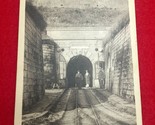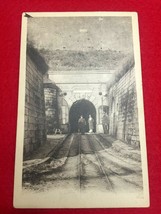Rendered at 09:41:26 12/01/25
Sign up and get $15.00 bCredits free to use at checkout and another $5.00 bCredits when you make your first purchase. More info
Envío gratis
10 recent views
WW1 - Verdun - France, An Entrance Of the Citadel's Underground Galleries7 KM...
$7,796.24 MXN
(Buy a 30% discount card for $30.00 first, and you will save $55.25 on this item and get up to 30% off future purchases for the next 3 months)
Sign up and get $15.00 bCredits free to use at checkout and another $5.00 bCredits when you make your first purchase. More info
Los buques de
United States

Share & earn! Sign in, share this or any listing, and you’ll get commission when it sells.
Learn more
Las opciones de envío
Los buques de 2 business days Detalles
No hay precio de envío se especifica en MX
Los buques de
United States

Política de oferta
OBO - El vendedor acepta ofertas en este artículo.
Detalles
La política de devoluciones
Full refund available within 30 days
Protección de compra
Opciones de pago
PayPal accepted
PayPal Credit accepted
Venmo accepted
PayPal, MasterCard, Visa, Discover, and American Express accepted
Maestro accepted
Amazon Pay accepted
Nuvei accepted
Las opciones de envío
Los buques de 2 business days Detalles
No hay precio de envío se especifica en MX
Los buques de
United States

Política de oferta
OBO - El vendedor acepta ofertas en este artículo.
Detalles
La política de devoluciones
Full refund available within 30 days
Protección de compra
Opciones de pago
PayPal accepted
PayPal Credit accepted
Venmo accepted
PayPal, MasterCard, Visa, Discover, and American Express accepted
Maestro accepted
Amazon Pay accepted
Nuvei accepted
Rasgos del artículo
| Categoría: | |
|---|---|
| cantidad disponible: |
Sólo uno en stock, para muy pronto |
| Condition: |
Used |
| Theme: |
Militaria |
| Seller Notes: |
Detalles del anuncio
| Envío de descuento: |
Vendedor paga el envío para este artículo. |
|---|---|
| Publicado en venta: |
Más de una semana |
| Artículo número: |
1367948580 |
Descripción del Artículo
Postcard Details
Verdun - France, An Entrance Of the Citadel's Underground Galleries.
History Of Verdun and Postcard
Verdun, the name of a citadel, but also the name of the deadliest battle of WWI. The largest city in the Meuse department, it has always been coveted because of its strategic location, a stone’s throw from Belgium, Luxembourg and Germany.The Gaulish stronghold of Verdodunum developed over 2,000 years ago.However, Verdun appeared in the history of France in 843AD, when the Charlemagne's empire was divided between his 3 grandsons, at the death of their father Louis the Pious.The frontiers of their respective kingdoms changed over the centuries.However, they correspond roughly to present day France, Germany and Lorraine.
The land Lothaire inherited became known as Lotharingia (Lothaire’s land), present day Lorraine.Verdun became a Free Imperial City of the Holly Roman Empire from 14th to the 16th century.
La Citadelle,The city had been fortified since ancient times.However, Marshal Vauban built the Citadelle in the 17th century.Verdun remained an important garrison town until the 18th century.
The Prussians captured it, however, at the beginning of the French Revolution. They indeed attempted to march on Paris, but were defeated at the Battle of Valmy on September 20, 1792.
They attacked it again during the Franco-Prussian War of 1870-71; Verdun was the last stronghold to surrender. Germany annexed Alsace and part of Lorraine on May 10, 1871 with the Treaty of Frankfurt.
The Meuse remained French, however, Verdun was located a mere 45kms away from the German border!Ten defense forts were immediately built around the city in order to protect the region. Between 1880 and 1914, a second defense belt was built in a 45km perimeter. It included 43 new forts and strongholds. This gigantic line of defense, centered on the underground citadel of Verdun, included Douaumont and Vaux.
These two forts played a prime role during the Battle of Verdun from February 21 to December 20, 1916.Verdun was the epicenter of this conflict that cost the death of thousands of soldiers.
Indeed, the Germans positioned themselves on 3 sides of Verdun and therefore isolated the citadel in a salient.
The 4 km of underground galleries, dug under the citadel between 1886 and 1893, were extended to 7km during WWI. A whole infrastructure was also put in place in order to accommodate up to 2000 soldiers. This included ammunition and powder magazines, a telegraphy and telephone station, a water supply network, but also a mill, a bakery, kitchens etc .
The picture in the postcard is of the above gallery. This gallery is converted to museum now and open to the public.
[History Source - Travel France Online]
Added to your wish list!

- WW1 - Verdun - France, An Entrance Of the Citadel's Underground Galleries7 KM...
- 1 in stock
- Price negotiable
- Handling time 2 day.
- Returns/refunds accepted
Get an item reminder
We'll email you a link to your item now and follow up with a single reminder (if you'd like one). That's it! No spam, no hassle.
Already have an account?
Log in and add this item to your wish list.





